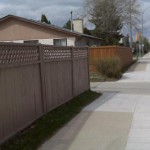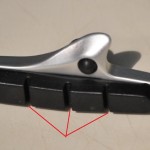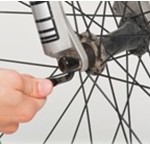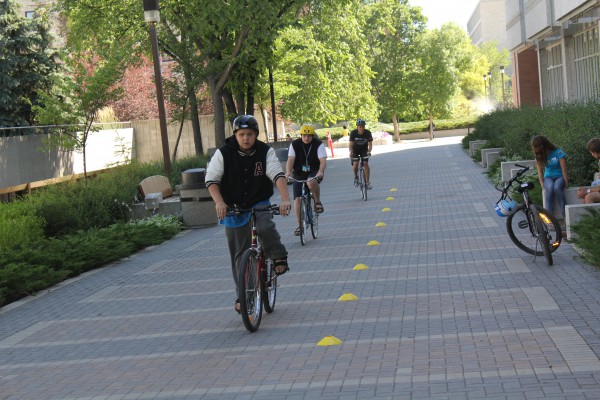Our 7 mistakes series has so far looked at people who ride bikes, driver misunderstandings and engineers. As our next installment, I thought that we should look at the future, our children. As a Can-Bike instructor I see people making all kinds of mistakes while riding their bikes. However, when I see young children or parents riding with their kids make some of these mistakes, it really hits home how the lack of proper education about riding a bike continues to put us in conflict with other road users. Here are my top 7 things that parents need to be more aware of when it comes to teaching their children how to ride a bike:
1. Not Demanding more from our education system
As parents we need to demand better education in our school system. In many European countries riding a bike is part of their culture, but they also educate their youth from the time they are young how to ride a bike. This is not just teaching them the basic hand signals, it is teaching them skills and appropriate behaviour when they are riding their bike. The education is progressive as the children get older – just imagine the advantage they could have as they reach an age where they can drive a car. Of course, when children reach their teenage years they may not follow everything they were taught, but they would have the knowledge and understanding of what they should be doing, and the alertness that they need on the road would have already been instilled.
In the Netherlands when children reach an age of 12 they take a “Verkeersexamen” or traffic test. It is a practical examination that includes both a written and on road test. The vast majority of these children will be riding their bikes to secondary school the following year. What their school curriculum has provided them is the skills and knowledge to do this safely. Sure we have a long way to go to match their cycling culture and infrastructure, but there is no reason we can’t start teaching our kids better bicycling knowledge and skills.
Here is a video Dutch children taking a “Verkeersexamen”
2. Not being informed of what kids need to learn
Parents make mistakes teaching their kids to ride bikes because they themselves were never properly educated on riding a bike and so the beat goes on and on. In many cases education about riding a bike ends when dad lets go of the bike and the child can balance on their own. I place myself in this same category as I did not teach my children when they were young either. What we have to remember it is not just “easy as riding a bike” and that there is much more that children and parents need to know to ride safely. Parents that understand proper riding practices and the skills needed to ride safely can not only better educate their children, but also demonstrate the appropriate behaviours when they ride with them.
While Manitoba does not have a specific bicycle safety and skills program, there are some courses out there. Each spring there is a commuter cycling course offered through the City of Winnipeg’s Leisure Guide. Manitoba Public Insurance (MPI) also offers a “Cycling Champions” course through their road safety division. In the absence of a readily available cycling courses there is also lots of information available on-line. MPI has a fairly extensive bicycle safety section on their website at http://www.mpi.mb.ca/en/Rd-Safety/Cycling/Pages/BikeSafe.aspx. Remember however that just reading the information does not generally lead to making you a better bike rider, you need to practice what you’ve learned in order to break the habits that you spent many years developing.
In the same way that we need to demand better cycling education for our children, maybe we should also be asking our government to provide a program of bike education for adults too. Even if we had a program in our schools today, we would be waiting a long time to see any real change in people’s behaviours and understanding of riding a bike.
3. Thinking that kids should always ride on the sidewalk
There is a reason that riding on the sidewalk is illegal: it’s more dangerous. Unless your children are riding a bike with a wheel sizes of 16 inch or smaller, they really should be riding on the road. While a small child riding with their parent beside them on a sidewalk is quite safe, older children riding on their own are not unless they are extremely alert at ALL intersections.

Photo – Green Action Centre
This is especially true at driveways and back lanes, where there is no stop signs and in some cases the drivers view of the sidewalk is obstructed by trees, fences etc. Teaching children to ride on the roads once they are old enough to understand the rules (again stressing the need for education) is important. Generally children of 8 or 9 years old are developing the cognitive and motor skills required to analyze traffic and handle their bikes appropriately. Riding on the road will make them more visible to drivers and they will eventually be able to ride their bike anywhere they need to go safely.
4. Not Teaching them to shoulder check and signal
Experience has made me aware of the important of signalling; in fact I believe it to be one of the most important skills we can teach our children about riding a bike. They need to understand that signals need to be clear and definitive. An arm hanging at your side is not a stop signal, it is just a sign that you are riding with one hand.
When we signal our intentions, we are communicating with other road users and making ourselves more predictable. We also need to teach children that it is important to shoulder check before they signal or change their position on the road. Shoulder checking is also a form of communication to drivers and alerts them to an intended movement.
5. Assuming that if they can balance they can ride a bike
Riding a bike on 2 wheels starts with balance, but does not stop there. And speaking of stopping, that’s an important skill that needs to more teaching than just how to press the pedals backwards (coaster brakes) or squeeze the brake handle. Most kids learn pretty quickly how to skid their back tire (and wear it out too) but this really does not allow them to stop quickly if needed. In Can-Bike we teach a skill called threshold braking (see this video) or panic stops. While this technique is a bit too complicated for younger children, understanding how their brakes work is important. This is particularly important when it comes to using the front brake, which provides 80% of a bike’s braking power. Squeezing this brake too hard, too quickly, can send you child over the handlebars and destined for at least some painful cuts and scrapes. Teach your children how to use their brakes effectively and help them avoid a potential tumble. As they get older make sure that they understand the difference between skidding to a stop and coming to a stop quickly.
Another skill that is overlooked by almost everyone is straight line riding. While this seems like a simple thing to do, just try it see how straight you can ride, especially when you add in a shoulder check and/or signal. It takes practice to make a shoulder check and not end up weaving in the direction of the shoulder you are looking over. It’s also not a bad idea to set up a simple obstacle course for your child to help them practice their balance, turning and avoiding obstacles.
6. Not getting a bike that fits
All children grow, but making them grow into a bicycle is not the same as growing into clothing. A bike that is too big (or too small) will be a challenge for a child to control or manoeuvre properly. If we expect them to be able to ride properly then they need a bike that fits properly.

Photo from MPI – by permission
When your child is standing over the top tube of their bike there should be about 3 to 5 centimetres between them and the highest point on that top tube. This is a general rule of thumb and so it is always a good idea to get some expert help when choosing a bike. Check with your local bike shop or one of the many community bike shops for advise. If you insist on purchasing bikes from the big box stores then good luck with getting the right advice there. Most bike shops are happy to provide advice even if you don’t buy a bike, but remember that not all bikes are built the same and so a 16” bike at Wal-Mart is not necessarily the same as the 16” bike that you saw at your local bike shop.
While you are making things fit, since helmets are now mandatory for children under 18, make sure that the helmet they are wearing fits properly as well. Check out this link for the basics of helmet fit or watch this fun video.
7. Not maintaining bikes
Before you teach your child to ride or in fact until they are old enough to understand whether their bike is safe to ride, you really should check it over. General maintenance can help any bike last longer and run better, but there are a few basic checks that we as parents should be doing on our kids’ bikes regularly to make sure that they are safe to ride. Many of us tend to wait until our kids alert us to something that is not working with their bike before we look at it. If this happens to be the brakes, it could be quite serious. Here are a few quick checks you can do:
- Check the tire pressure and make sure they are inflated properly. Riding on tires that are too low can not only result in a flat tire, but also makes the bike more difficult to control. For the right tire pressure for each bike check the sidewall of the tires. While you’re at it, check to make sure that the wheels spin straight and true. If they wobble then the braking against the rims of the wheels could be greatly reduced.
-

Photo – Green Action Centre
Check the brakes to make sure that the brake pads are aligned properly with the rims and that the brake levers do not pull all the way back to the handle grips. There should be at least a fingers width between the lever and the bars. As brake pads wear this distance is reduced. You can use the barrel adjustor on the brake to make minor adjustments. It is also a good idea from time to time to check the brake pads for wear. Most brake pads have wear indicators that will give you an idea as to when they should be replaced.
- Check the handlebars to make sure they are tight. Hold the front wheel tightly between your legs and try to twist the bars from side to side. Also try pressing down on the bars and make sure that they do not turn downwards.
-

Photo from MPI – by permission
Check the bolts or quick releases on the wheels to make sure they are tight. Many bikes these days come with quick releases on the wheels, in particular the front wheel. These can come loose or open if they catch on a bike rack or other object.
- Lastly, just pick the bike up off the ground and give it a drop. This might just alert you to something that is loose or falling off.
Some final thoughts
Bikes give children freedom and independence. They can also be having fun while not being a constant source of worry for parents. Education is a key ingredient to making cycling safer. More importantly, since we all want to see our children off the couch and getting more exercise, why not have them riding their bikes more often. If we provide them with the knowledge, understanding and skills, they will be better cyclists while we can relax and let them enjoy the ride.
Unfortunately many of us do not appreciate the value of cycling education and hence our politicians put very little priority on it. We need to promote this aspect of riding a bike and push for better education. We know the kind of change that is possible when government makes riding a bike a priority (see # 1) and clearly education is part of that change.
If you still have not had enough, check out our walking and wheeling webinar series that not only includes a presentation that I did on bike safety tips for kids, but also:
- How to start a bike repair program in your school
- Winter walking activities
- Building a culture of walking and cycling in your school
- Pedestrian and Bicycling Engineering 101 for school travel
Note: You may have to do some set-up in order to login to the Wimba Classroom, but the presentations are worth the effort.




Every parent needs to read this article. With a balance bike, kids can learn perfect riding.Wheelgadget.com is a balance bike review website. Read the best review and learn how to choose the perfect bike for your little one.
Thanks for sharing such useful tips! I would especially like to re-mention that important point about kid’s riding on sidewalks. I think this is the most dangerous thing mainly because I have seen it turning into ugly situations. Teaching bike riding is not all about balancing. Instead teach them what is to be done for maintaining safety. Teaching ethics and rules is a prerequisite.
Good site you’ve got here.. It’s difficult to find good quality writing like yours these days. I truly appreciate people like you! Take care!!|
I am currently trying to organize a group cycling tour to help build my local touring community. Recently my thoughts have gone to better ways to carry gear on the bike. What I have seen here further reinforces what I am coming to understand as a backpacker approaching bike touring. Great article.
One very important thing as well is to lead by example. I can’t count the number of occasions I’ve seen families out riding together. Kids are wearing helmets, parents are not. What kind of message is that sending?
Just my 2 cents.